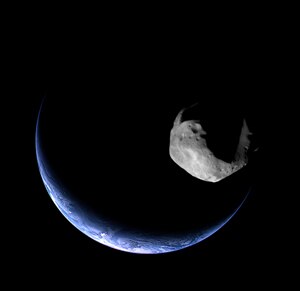Create a free profile to get unlimited access to exclusive videos, sweepstakes, and more!
Good News, Everyone: Asteroid 2013 TV135 No Longer a Threat

After writing about small impacts being more common than we previously thought, I have some good news: The chance of an impact from the newly-discovered asteroid 2013 TV135 have dropped to essentially zero.
Yay! But this is hardly surprising.
This rock was discovered in October 2013 by astronomers at the Crimean Astrophysical Observatory, and was quickly determined to have an orbit that might bring it uncomfortably close to Earth in 2032. However, that was based on a small number of observations, making it difficult to make a prediction of its precise location so far in the future. As we got more observations, I noted, the chance of an impact was likely to drop to zero â after actually increasing temporarily.
And thatâs exactly whatâs happened. The initial 1 in 63,000 chance of impact, calculated using those first few observations, went up as high as 1 in 10,000 after a few more. But now, with well over 600 observations spanning three weeks of time, the chance of an impact has dropped to about 1 in 28 million. In other words, there is a 99.999996% chance it will safely glide on past the Earth in 2032. Once the chance drops like this, it usually stays pretty low. Of course, astronomers will continue to observe this asteroid, because honestly thatâs what astronomers do. It's still an interesting object, worth studying.
[UPDATE (Nov. 7, 2013 at 16:00 UTC): I just learned from JPL engineer Ron Baalke that since I wrote this post last night, the chance of an impact has dropped even more, to 1 in â get this â 169 million. Ha! That's a 99.9999994% chance of a miss. I'd bet quite a bit of money on a safe pass.]
Iâll add that this good news comes on the heels of some slightly more iffy news: Three new near-Earth asteroids have been discovered, one of which can actually get pretty close to Earth, close enough to categorize it as âpotentially hazardousâ.
Now, donât flip out about that. Thatâs a pretty wide bucket to put asteroids in; for example, this new one, called 2013 UP8, only gets to about 5.5 million kilometers (3.4 million miles) form Earth. Thatâs almost 15 times farther away than the Moon, so in real-world terms, this rock isnât too big a worry. Which is nice, because itâs about two kilometers across, so we really donât want it hitting us!
Itâs avoided detection for so long because it hasnât passed near Earth for a while; its orbit takes it out past Mars, and it hasnât been well-positioned for viewing when itâs been closer. Its orbit is also highly inclined to the Earthâs, tipped by 48°! So even when it looks like itâs near us in a diagram like the one above, thatâs only because the third dimension has been flattened; itâs a perspective effect.
The other two asteroids never get near the Earth, which really is good news, since theyâre both roughly 20 km (12 miles) across! Thatâs pretty dang big; so big I was initially surprised they escaped detection this long. One, 2013 UQ4, is on a highly elliptical orbit and also goes around the Sun in the opposite direction of the planets. That is a sure sign itâs a burned-out comet. Its orbital period is over 500 years long, which may explain why we havenât seen it before! It hasnât been around this neck of the woods for a few centuries.
The other one, 2013 US10, is a bit of a surprise, because it is big enough to be seen in surveys. It has an orbit that takes it out past Jupiter, but is again inclined to the Earthâs orbit. It never gets closer than about 80 million km to us, which may be why it hasnât been spotted before now. Like UQ4, thereâs no chance of it ever hitting us.
[UPDATE 2 (Nov. 7, 2013 at 16:10 UTC): Well, this is interesting: 2013 US10 was initially classified as an asteroid, but now that's been changed to a comet! The new name for this object is C/2013 US10 (Catalina). It turns out that two new observations were added, and an earlier one was removed (it was mixed up with another object, apparently). When all the new data were crunched, it turns out the comet is on a very long, hyperbolic orbit, meaning this may be its first pass into the inner solar system. It's also showing a bit of cometary activity, meaning ice on the comet is turning into a gas and leaving the surface. This makes the comet brighter than an asteroid, so it may in fact be smaller than first thought (the size of an asteroid is based on how bright it is).]
So really, none of these three new asteroids is a threat. However they underscore the need for more survey observatories to go sniffing around the sky. I donât like that objects that big can still hide from us.
These new rocks are a reminder that there are still quite a few out there, and we need to be ever-vigilant looking for them. Itâs always good to know more about the Universe â science is pretty cool that way â but in this case it just might save the world.
Tip oâ the Whipple Shield to Asteroid Watch on Twitter.














